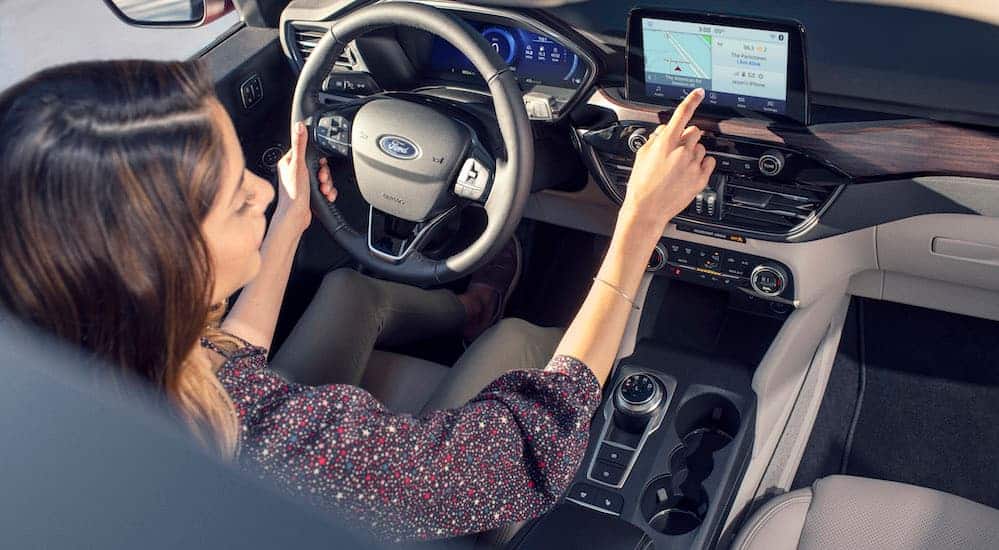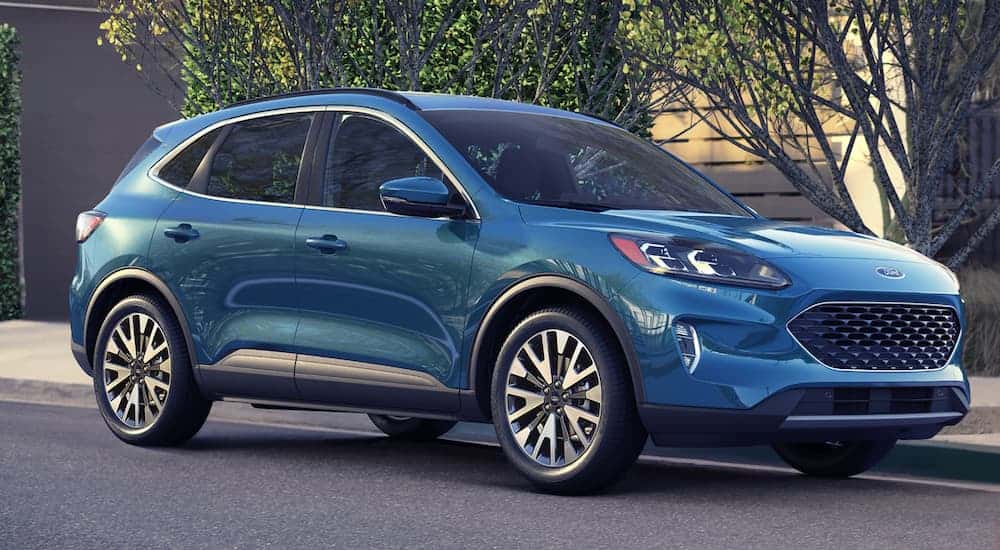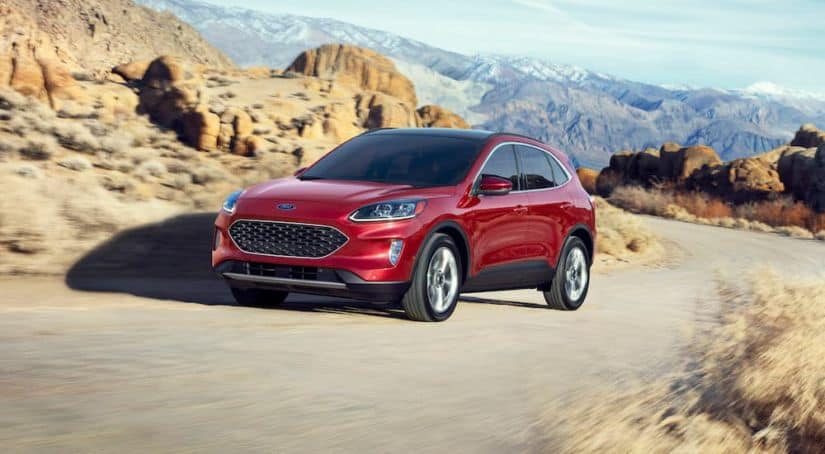Small crossovers are exactly what more and more people want these days- they perform better in crashes than smaller cars, offer a better field of vision, are more comfortable, you can convert them from passenger transportation machines to cargo transportation machines and back again, and they can flex into doing handy things like towing when they need to. Their fuel efficiency is getting better and better as technology advances, and so does the experience driving or simply staying inside the parked vehicle as more and more conveniences are added to modern vehicles. There isn’t much they can’t do, which is why so many people want them- if you want the flexibility to be able to be good at anything, and guaranteeing a great driving experience, they’re the way to go. And if you’ve brought it down to a comparison of the 2020 Ford Escape vs 2020 Nissan Rogue, you’re in good company. Let’s compare the two and see which fits your niche better.
Comfort in the Cabin
When it comes to the car’s compartment, more space is what everyone wants, to keep themselves comfortable and carry their gear without inconvenience whenever they want to. The 2020 Nissan Rogue boasts 43 inches front legroom, 41.6 inches front headroom, and 56.6 inches front shoulder room to keep the most used seats in the vehicle, and the passenger fast enough to claim shotgun the most comfortable. In the back there are 37.9 inches of rear legroom, 38.5 inches of rear headroom, 55.9 inches of rear shoulder room to keep everyone plenty happy.
In the end, this leaves a decent 39.3 cubic feet of cargo space to work with when all the seats are up, turning into 70 cubic feet when they’re down. One downside to the Rogue is that the bottom of the seats will raise and lower to suit the driver’s leg height, it does not tilt to accommodate more comfortable postures. It does, however, conveniently have the ability to save driver preferences, and restore your seat to how you’re used to having it at the push of a button.
By comparison, the 2020 Ford Escape has 42.4 inches front legroom, 40 inches front headroom, and 57.6 inches front shoulder room, very similar dimensions. In the back, passengers keep 40.7 inches for rear legroom, 39.3 inches rear headroom, and 56 inches rear shoulder room. Again, very similar, however, there is slightly more cargo room in the Rogue, with the escape only having 34 cubic feet of cargo space with the seats up, and 68 cubic feet when they’re down. Ford has also worked hard to improve the ride quality from the previous Escape, a complaint many consumers had with the previous model.

High Tech Toys and Tools
The Escape comes with smartphone connectivity, AM/FM radio (and optional XM). There is the option of WiFi availability (on select models) that you can connect up to 10 devices to; additionally, you can be up to 50 feet away from the vehicle. To optimize the driving experience, Ford has several different drive modes you can set your car to with the push of a button, depending on the situation you find yourself in. This could be helpful if you do any off-road driving or if you ever drive through snow.
The Rogue offers NissanConnect, which allows you to start your car remotely, lock/unlock doors, and flash the lights. The infotainment system has Apple Auto and Android Carplay (comparable to the Escape), and much much more through convenient voice commands that let you audibly tell your car what to do, even remotely, through your phone.
The Escape offers many of the same amenities, and they both share blind-spot monitoring, a rearview camera, backup assist, automatic emergency braking, and lane centering/departure assistance. One of the neat features the Rogue offers is vehicle dynamic control, which, as the vehicle starts spinning out (say, from going around a slick corner) it reduces engine output and applies the brakes to specific wheels to help you regain control. One of Ford’s neat features is emergency evasive steering, to help you avoid crashes.
The Heart and Soul of the Vehicle
The Rogue is available with two engine offerings (including the Rogue Sport). The Escape is available with a 1.5 L Ecoboost, 2.0 L Ecoboost, 2.5 L hybrid, and 2.5 L hybrid plug-in engine options.
The Rogue comes with a 2.5L 4-cylinder engine with 170 horsepower and 175 foot-pounds of torque. The Rogue Sport comes with a 2.0L 4-cylinder engine that gets 141 horsepower and 147 lb-ft of torque. Presently, the Nissan Rogue does not have a hybrid variant.
Ford’s engines start with a 2.5L 4-cylinder hybrid and hybrid plug-in engine, a 1.5L EcoBoost engine, and a 2.0L EcoBoost engine. One of Ford’s greatest advantages is the engine offerings. A hybrid option certainly gives this model an edge.

The Escape also boasts some bold decor styling as Ford integrated wood grain trim and depression-patterned gray. The Escape has also gone ahead and lost 200 pounds off its curb weight, using among other things high strength steel that require less material, and a collateral advantage to this is smaller front pillars, meaning greater visibility for the driver. In the future, Ford is planning to redesign the placement of USB charging ports to optimize accessibility and convenience, and assuredly many other fine-tuning tweaks and cool new features to amplify its place as a leading small size crossover.
The Winner
Overall, we just have to recommend the 2020 Ford Escape with its brand new redesign helping it emphasize the “Sport” in Sport Utility Vehicle. The wider cabin and airier feel due to lower windows help create the atmosphere small crossover buyers are usually looking for. The 1.5L EcoBoost engine also comes with cylinder deactivation, meaning greater fuel efficiency across real-life scenarios.
On the Titanium trim, the 12.3-inch customizable instrument cluster replaces the typical instrument panel behind the steering wheel. The 8-inch touchscreen with SYNC 3, head-up display, rotary shifter in the center console, sliding back seats that help you balance the load between cargo and leg space, make this an excellent vehicle. Dan Edmunds, Director of vehicle testing for Edmunds car reviews said that the 2020 Escape “has changed [his] mind about what an Escape is” because of the improvements to attractiveness and features offered.
The Nissan Rogue is a good vehicle, popular, and competitive with the Escape. It’s done better in crash tests, and it has some useful folding compartment dividers to help you store things in the back. There are strengths and weaknesses to every vehicle, and what’s “the best” pick may not be the best for you. Still, if you share the common motivation that other small crossover buyers share: the optimal blend of passenger and cargo utility, a commanding driving experience, and a little bit of towing power – the Escape is the perfect vehicle.
And, if you want something a bit bigger and beefier, down the road, Ford plans to unveil the Bronco, an SUV that fits the needs of those who want just a little more space while maintaining style.



